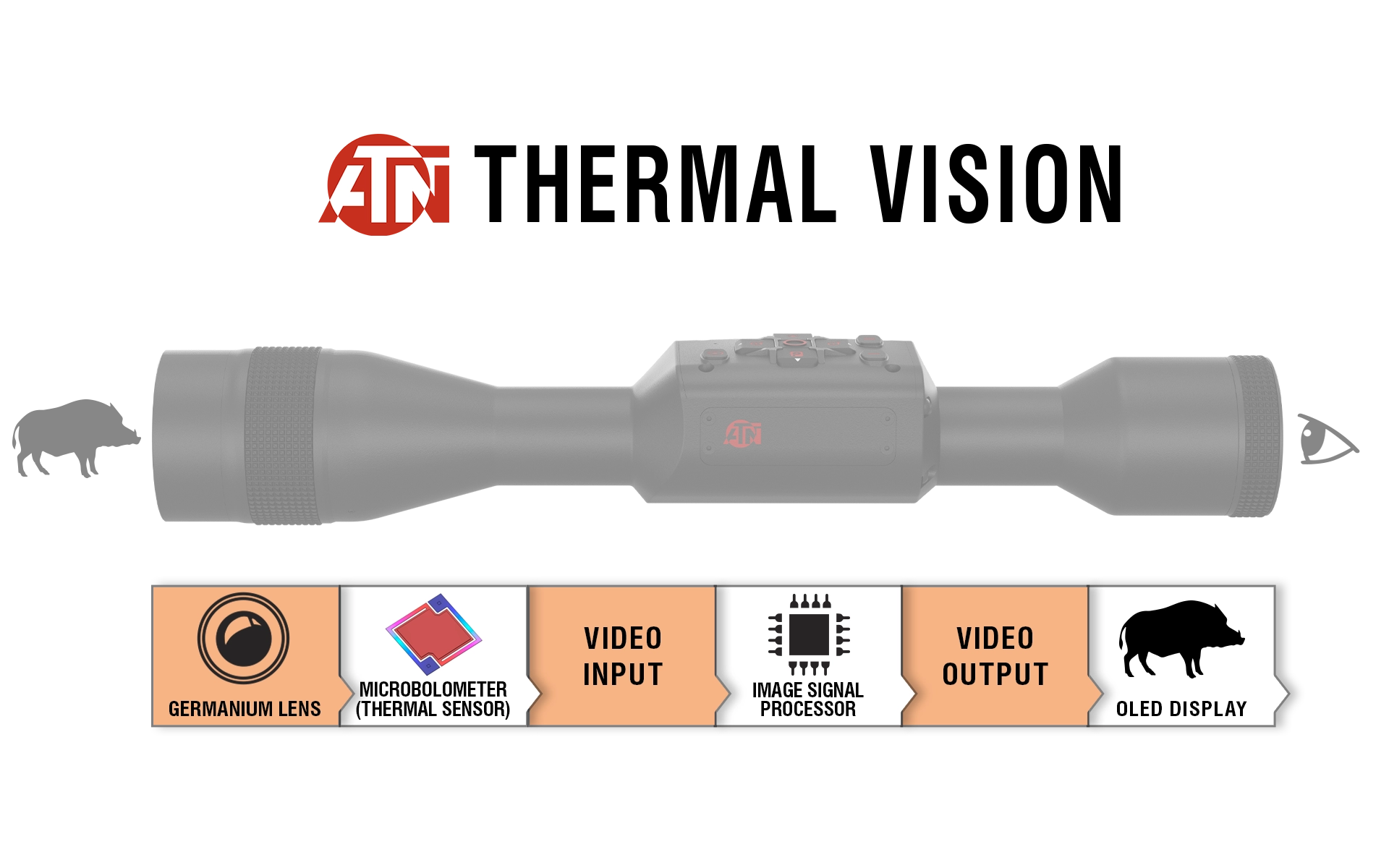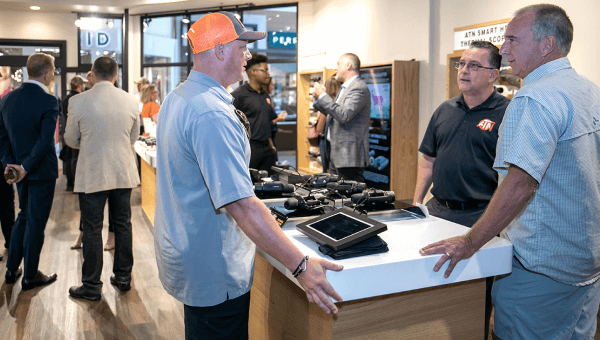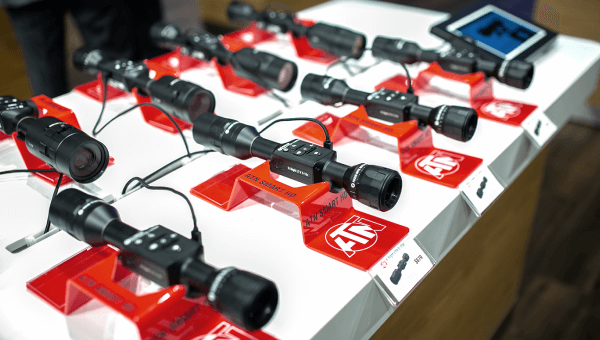How Thermal Imaging Works?
What is thermal imaging?
All objects, both natural and manmade, emit infrared energy as heat. By detecting very subtle temperature differences of everything in view, infrared (or thermal vision ) technology reveals what otherwise would be invisible to the naked eye. Even in complete darkness and challenging weather conditions, thermal imaging gives users the ability to see the unseen.
Thermal sensors detect heat emitted by objects, converting it into an electronic signal to generate a thermal image. This allows you to see temperature differences in the scope's field of view.

Applications in Various Fields
Hunting:
- Detection Advantage: Thermal scopes like the ATN Thor 5 640 make hunting at night, especially for hogs, varmints, and coyotes, incredibly effective. The heat signatures of these animals stand out against cooler backgrounds, even in total darkness.
- Example: A hunter using an ATN Thor 5 640 can easily spot the warm heat signature of a coyote moving through dense foliage, a scenario where traditional night vision might not be as effective.
Shooting:
- Target Acquisition: In shooting, especially in low-light conditions, thermal technology helps shooters quickly identify targets.
- Example: A shooter practicing at a range with dim lighting can use a thermal scope to better see and aim at targets that would otherwise blend into the dark background.
Home Defense:
- Intruder Identification: Thermal imaging plays a crucial role in home defense by allowing homeowners to detect intruders based on their heat signatures, providing an advantage in darkness or obscured conditions.
- Example: If an intruder hides in the bushes at night, their heat signature can be easily detected with a thermal imaging device, alerting the homeowner.
Security:
- Perimeter Surveillance: In security, thermal imaging is invaluable for monitoring large, dark areas where potential threats could hide.
- Example: Security personnel patrolling a large, dark property can use thermal imaging to quickly spot human figures, even if they are camouflaged or hiding in shadows.
THE MAIN PARAMETERS OF THERMAL IMAGING DEVICES
Thermal sensor size
The resolution of the thermal sensor, specifically the microbolometer, serves as a crucial parameter in evaluating sensor quality. It denotes the number of sensitive elements (pixels) that form the sensor, and a higher pixel count in sensors contributes to the production of more detailed images of objects.
Standard sizes for thermal imaging sensors are:
| Sensor resolution | Aspect ratio |
|---|---|
| 160x120 | 4:3 |
| 320x240 | 4:3 |
| 384x288 | 4:3 |
| 640x480 | 4:3 |
| 1024x768 | 4:3 |
Pixel Pitch and Thermal Imaging Sensor Measurement
When delving into the intricate technical specifications of a digital image sensor, one will inevitably encounter a critical metric known as "pixel pitch." In essence, pixel pitch is the width of an individual pixel on the sensor, usually expressed in microns (μm). This simplifies the calculation of the overall physical sensor size—just multiply the resolution by the pixel pitch. However, confusion arises when considering how these sizes impact thermal sensors' field of view and detail levels.
Unlike standard visible sensors, where increasing resolution without altering sensor size enhances image detail, thermal cameras follow a different paradigm. In thermal imaging, elevating resolution while maintaining the pixel pitch yields the same level of detail in an image but with a broader field of view.
In the context of pixel pitch differences, let's explore the distinctions between two common values: 17 microns and 12 microns.
17 Microns Pixel Pitch:
A pixel pitch of 17 microns implies that the centers of neighboring pixels are situated at a distance of 17 micrometers from each other. Sensors with this pixel pitch are likely to be larger in physical size, and this can offer advantages such as improved light sensitivity. The larger pitch can be beneficial in applications where a higher sensitivity to infrared radiation is crucial.
12 Microns Pixel Pitch:
On the other hand, a pixel pitch of 12 microns indicates a smaller distance between pixel centers. Sensors with a 12-micron pixel pitch are generally more compact, allowing for higher pixel density within the same physical sensor size. This can result in increased image resolution and finer details, making them suitable for applications where a high level of detail is essential.
At ATN corp, we address these distinctions by assessing a camera's effective detail using PPM (pixels per millimeter). Additionally, we utilize an in-house tool capable of previewing the field of view for most sensor sizes at any focal length. For assistance in selecting the optimal camera tailored to your application and budget, please don't hesitate to contact us today.
A SPECIAL LENS OF THERMAL SCOPE FOCUSES THE INFRARED LIGHT EMITTED BY ALL OF THE OBJECTS IN VIEW
The focused light is scanned by a phased array of infrared-detector elements. The detector elements create a very detailed temperature pattern called a thermogram. It only takes about one-thirtieth of a second for the detector array to obtain the temperature information to make the thermogram. This information is obtained from several thousand points in the field of view of the detector array.
The thermogram created by the detector elements is translated into electric impulses.
The impulses are sent to a signal-processing unit, a circuit board with a dedicated chip that translates the information from the elements into data for the display.
The signal-processing unit sends the information to the display, where it appears as various colors depending on the intensity of the infrared emission. The combination of all the impulses from all of the elements creates the image.
Unlike traditional most night-vision equipment which uses image-enhancement technology, thermal imaging is great for detecting people or working in near-absolute darkness with little or no ambient lighting (i.e. stars, moonlight, etc, ).
ATN uses specially designed germanium-coated lenses for all thermal products to provide more effective use of the devices.
ATN Thermal devices
At ATN, we make various thermal vision devices for hunters and nature enthusiasts. These include:
-
Thermal Rifle scopes: ATN offers thermal scopes designed to be mounted on firearms for hunting
and tactical applications. These scopes typically provide high-resolution thermal imaging for
target detection and identification.
ATN ThOR Series: The ThOR series includes thermal riflescopes with various features such as different sensor resolutions, magnification options, and ballistic calculators. Models within this series may include the ThOR 5, ThOR 5XD,, ThOR 4, ThOR LTV and ThOR LT. -
Thermal Binoculars: ATN's thermal binoculars are designed for increased situational awareness. These
devices often feature dual eyepieces and can be used for observation, reconnaissance, and surveillance.
ATN BinoX 4T Series: The BinoX 4T series features thermal binoculars with digital capabilities. These binoculars may offer features like built-in rangefinders, image and video recording, and the ability to share the thermal feed. Check for specific models like the BinoX 4T 640 or others. -
Thermal Monoculars: Compact and portable, thermal monoculars from ATN are designed for handheld use.
They are suitable for a variety of applications, including scouting, navigation, and general observation
in low-light or nighttime conditions.
ATN OTS Series: The OTS series includes handheld thermal monoculars designed for various applications. These monoculars may vary in terms of resolution, magnification, and additional features. Models like the OTS LT, OTS XLT and OTS 4T.
ATN ODIN Series: completely redesigned from The OTS series, slim and ergonomic, fits perfectly in your hand. Using our new Obsidian LT Core and Cutting-Edge sensors for sharp crisp images and extended range.



Dallas Store
3000 Grapevine Mills PWKY
Space #133 Grapevine, TX 76051
Austin Store
2901 S Capital of Texas Hwy
Suite N02, Austin, TX 78746
Houston Store
5015 Westheimer Road
Suite A1192, Houston TX 77056
Atlanta Store
5900 Sugarloaf Pkwy
Suite 513, Lawrenceville GA 30043
Chicago Store
GAT Guns Store 970 Dundee Ave
East Dundee, IL 60118



